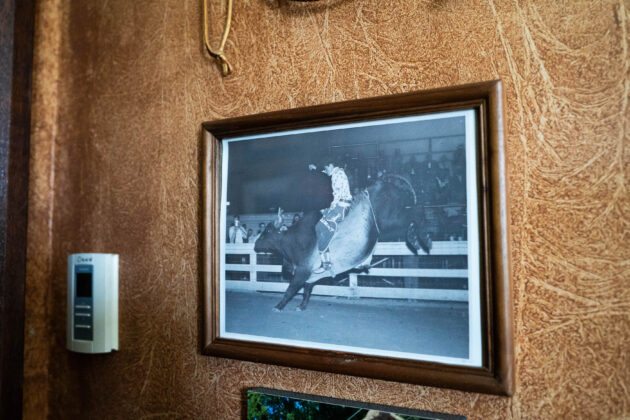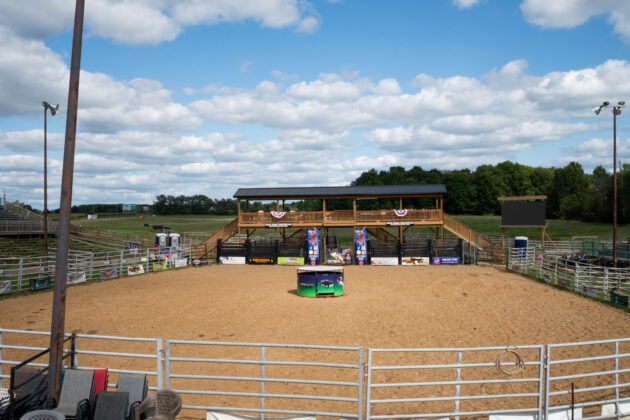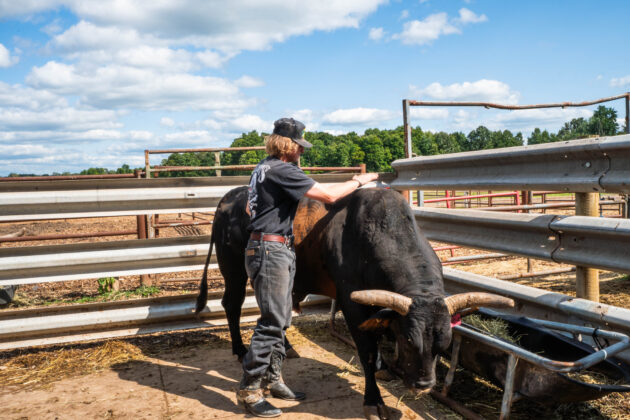
BURBANK, Ohio — The 8-second dance is what it’s all about for bulls at Buckin’ Ohio ranch and rodeo where anyone from all over can come and enjoy bull riders buck’ ‘em and ride ‘em. But operating this family-run business takes a lot more work than what folks see at the monthly rodeos.
From breeding, raising and training them, Buckin’ Ohio does it all when it comes to bulls. The Thorsell family first started putting on rodeos with their family friends. Today, thousands of people flock to the stadium for a seat.
“We’ve had people come from Germany. I’ve had people from Italy buy their tickets online,” said President and co-founder of Buckin’ Ohio Eileen Thorsell. “We’ve had people from all over the world. One of our goals is keeping the West alive in the Midwest.”

How it started
The idea to turn their Medina County property into a rodeo started with Eileen’s son Shawn Thorsell’s love of bull riding. Shawn started riding bareback horses and bulls in 1985 when he was 14 years old. As his love of riding grew, Eileen and her late husband and co-founder, Denny Thorsell, decided to buy bulls for Shawn to practice on.
Denny, who passed away in 2017, was an American Quarter Horse judge who traveled all over the world showing and judging horses. The Thorsells had been raising quarter horses and cattle for several years before deciding to purchase bulls for bucking.
Denny bought and sold bulls for a few years, but quickly realized it would be less expensive to breed their own. So, he began breeding his own bulls to make the perfect bucking bull. This led to the establishment of Creek Bend Bucking Bulls in 1994, the Thorsell’s breeding and bucking bull business.
Eventually, the Thorsells wanted to buy more cows to breed even better bucking bulls, so they bought a larger property. It was when they acquired their current 98.6-acre property in 2002 that the Thorsells began putting on rodeos with family and friends.
“We would have people show up when we were bucking our young stock, trying to figure out what we were doing. I just said to my husband, ‘We should just put on bull riding.’ We were getting 100 people here,” Eileen said.
In the beginning, a lot of the riders were Shawn’s bull riding friends. Oftentimes, they would live on the property and help maintain the ranch.
As they started launching their rodeo, the Thorsells also started hosting bull riding classes. Shawn and other bull riding professionals would come in and teach attendees the basics.
The first five years of Buckin’ Ohio were tough. The Thorsells had to learn how to market the business and attract a new audience besides their loyal friends and family. If they didn’t expand their reach within five years, the plan was to return to breeding cows and only bucking bulls for the Professional Bull Riding League, PBR.
Fortunately, in their fifth year of operations, Buckin’ Ohio grew with more people coming to the rodeos. At the time, the audience sat on straw bales instead of the stadium bleachers present today. All the workers hated the straw bale seats, but the public thought it was cool.
“When the bull riding was over, all the guys had to go and stack the (straw), and then we had to cover it because we needed to use it again,” Eileen laughs. “It was (straw) we’d use for bedding (and) we couldn’t let it get wet.”
Just like their seating, the business would start to evolve as well.
Growth
Eileen put advertisements in the local newspaper and handed out cards at community events to attract a larger audience. In its first five years, Buckin’ Ohio saw the audience grow from 300 to 500 people a night. At their recent July rodeo, the rodeo had a turnout of roughly 5,000 people.
Buckin’ Ohio hosts six rodeos each year between the months of May and October. A lot of the main attractions like the bulls, general store and other concessions are run by family members, from Eileen’s children and grandchildren. They also have roughly 30 staff members who come and help the night of the show.
To compete in the shows, all riders need to do is call in and enter. The fee to ride is $100, 75% of which goes back into the potluck for the winning rider. Buckin’ Ohio takes up to 30 riders and the final prize can be up to $8,000.
As the rodeos’s popularity grew, the family started looking for ways to diversify the shows; so, they created themed rodeos. They kick off Memorial Day every year with a Veterans Day-themed rodeo where they honor the different branches of the United States military.
In August, they celebrate American farmers by inviting farmers to the show, displaying antique tractors and farm equipment and selling local produce.
In addition to the rodeos, the Thorsells continue to host bull riding classes. They host a weekend-long bull riding class every June led by Tristan Thorsell, Shawn’s son who is also a bull rider. Participants learn the basics of bull riding and, later on, ride one of their “seasoned” bulls — bulls that are often going into retirement.
The bulls and misconceptions
The monthly rodeos are only a fraction of Buckin’ Ohio’s operation; most of it is centered around animal care and training.
The bulls are bred and raised to buck from a young age. Currently, the ranch has 20 bulls, two longhorn steers and five cows. Tristan primarily handles operations pertaining to training and preparing the bulls for rodeos.

Tristan and the family prioritize making the bulls feel comfortable in the arena and bucking shoot when they’re young.
“They’re like any animal. They’re scared they don’t know what’s gonna happen,” Eileen said. “You want to do everything really slow with them (when they are young) and just let them kind of walk in that area. You’re letting them feel comfortable and not be afraid, because you don’t want them to injure themselves. It’s like you’re training a child.”
The Thorsells start “training” the bulls at 2 years old by placing a rider on them and moving up and down — known as shoe breaking. This helps the bulls get comfortable with having a person on their back and prepares them to “do that 8-second dance,” Tristan said.
They also teach the bulls how to leave the arena by putting feed in their pens behind the bucking shoot. Tristan emphasizes teaching the bulls where the outgate is located is especially important because they could stay out and try to fight the riders. But, he adds, bulls often have a stubborn mind of their own.
“The only thing that you can train a bull to do is leave the arena and stand good. Other than that, they’re gonna do what they wanna do,” Tristan said.
Besides day-to-day activities — like tossing hay, filling water buckets and cleaning stalls — Buckin’ Ohio also performs consistent upkeep on the bulls by maintaining their hooves and monitoring their horns; the bulls are prone to horn infections.
One of their most famous bulls, named Trump, had a horn infection, and if the horn wasn’t removed, the infection would’ve spread and killed him. Fortunately, they caught the infection in time, and today, despite the loss of a horn, Trump is still as feisty as ever.

Regardless of all the tender love and care the Thorsells give their bulls, they still experience an onslaught of misconceptions.
“That’s the worst thing about the misinformation. People think that these bulls are just treated like crap. That is the furthest thing from the truth,” Tristan said. “Our bulls get bucked once a month, they work 8 seconds a month, and half of the time they don’t even work that long because no one rides them (that long).”
One of the most widely told misconceptions in bull riding is that rodeos put a rope around a bull’s testicles to get them to buck, but this is not true. “Man or beast is not going to move if anything is wrapped around there,” Charis Nelson, Eileen’s daughter said.
Sometimes, the Thorsells will use a flank strap — a fleece-lined leather strap — that is placed around a bull’s body and tickles it to enhance the buck. But most times, the bulls will buck perfectly fine on their own.
Future
As fall nears, Buckin’ Ohio will perform its final show for the 2024 season on Oct. 5.
Their final show every year celebrates the American cowboy and is known as the Tournament of Champions, where the best riders of the season come out to compete and get awarded buckles. They also give awards out to the best female and male mutton busters — sheep riding for kids — and name a bull of the year.
Buckin’ Ohio hopes to continue to grow and put on bigger rodeos someday. But for now, the Thorsells are grateful for the events they’ve been able to host and the smiles they’ve been able to create.
“The blessing is watching people and seeing them have fun, and watching little kids who are gonna get on a sheep for the first time or little kids who just got their cowboy hats and boots on and they finally got to be a cowboy for the night,” Eileen said. “It’s (about) the atmosphere you create and how you affect people’s lives.”
(Liz Partsch can be reached at epartsch@farmanddairy.com or 330-337-3419.)


































